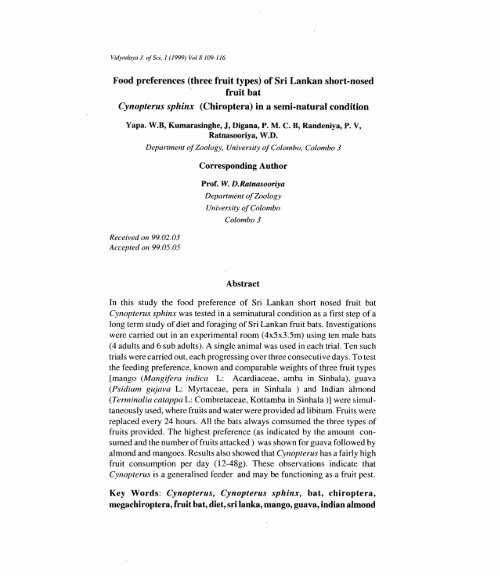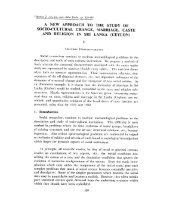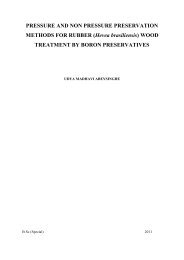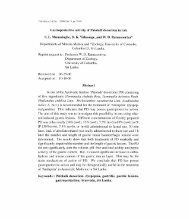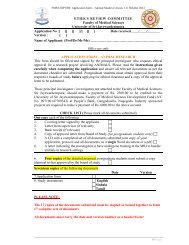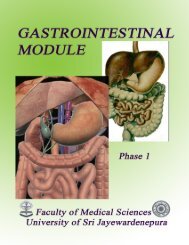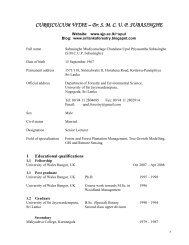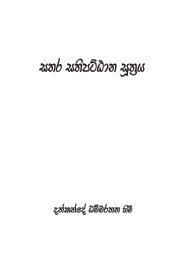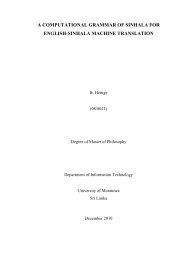Food preferences.pdf - Dl Sjp Ac Lk
Food preferences.pdf - Dl Sjp Ac Lk
Food preferences.pdf - Dl Sjp Ac Lk
- No tags were found...
Create successful ePaper yourself
Turn your PDF publications into a flip-book with our unique Google optimized e-Paper software.
Vidyodaya J. of Sci, / (/999) Vo/8 /09-//6<strong>Food</strong> <strong>preferences</strong>(three fruit types) of Sri Lankan short-nosed, fruit batCynopterus sphinx (Chiroptera) in a semi-natural conditionYapa. W.B, Kumarasinghe, J, Digana, P. M. C. B, Randeniya, P. v,Ratnasooriya, W.D.Department a/Zoology, University a/Colombo, Colombo 3CorrespondingAuthorProf. W. D.RatnasooriyaDepartment a/ZoologyUniversity a/ColomboColombo 3Received on 99.02.03<strong>Ac</strong>cepted all 99.05.05AbstractIn this study the food preference of Sri Lankan short nosed fruit batCynopterus sphinx was tested in a seminatural condition as a first step of along term study of diet and foraging of Sri Lankan fruit bats. Investigationswere carried out in an experimental room (4x5x3.5m) using ten male bats(4 adults and 6 sub adults). A single animal was used in each trial. Ten suchtrials were carried out, each progressing over three consecuti ve days. To testthe feeding preference, known and comparable weights of three fruit types[mango (Mangifera indica L: <strong>Ac</strong>ardiaceae, amba in Sinhala), guava(Psidium gujava L: Myrtaceae, pera in Sinhala ) and Indian almondtTerminalia catappa L: Combretaceae, Kottamba in Sinhala)] were simultaneouslyused, where fruits and water were provided ad libitum. Fruits werereplaced every 24 hours. All the bats always comsumed the three types offruits provided. The highest preference (as indicated by the amount consumedand the number of fruits attacked) was shown for guava followed byalmond and mangoes. Results also showed that Cynopterus has a fairly highfruit consumption per day (12-48g). These observations indicate thatCynopterus is a generalised feeder and may be functioning as a fruit pest.Key Words: Cynopterus, Cynopterus sphinx, bat, chiroptera,megachiroptera, fruit bat, diet, sri lanka, mango, guava, indian almond
110 Yapa, Kumarasinghe Digana, Ratnasooriya1. IntroductionFruit and nectar- eating bats are vital to the survival of tropical rainforests. It is estimated that in the Old World tropics alone, over 300 plant.species depend on bats for seed dispersal and pollination (Bat ConservationInternational, 1989). These include many economically important plantspecies such as durian (Durio zibethinus), dates (Phoenix dactylifera),breadfruit (Artocarpus communis), avocados (Persea americana), peaches(Prunus persica ) and mangoes (Mangifera indica). The diet of fruit eatingbats comprise of several varieties of fruits, pollen, nectar (Bonaccrorso1979, Sosa & Soriano ,1996) and leaves (Kunz & Diaz, 1995).There are only three species of fruit bats in Sri Lanka; Pteropusgiganteus, Rousettus leschenaulti and Cynopterus sphinx (megachiroptera)as opposed to 25 insectivorous (microchiroptera) species (Bates & Harrison,1997). However, apart from casual records (Phillips, 1980) of the types offruits such as guava (Psidium gujava), soursops (Annona muricata), mangoes(Mangifera indica) and the fruits of several species of palm treesconsumed by Sri Lankan bats, the diet and the dietary preference of thesewere not investigated. It was brought to the notice by farmers that fruit batsare one of the most notorious frugivores that cause heavy damage to fruitsin home gardens as well as in large fruit plantations. Since bats forage in thenight, often unseen by any observer, the farmers have become helpless inprotecting their fruits from bats. It was also indicated that out of many locallygrown fruits such as papaw (Carica papaya), banana (Musa parasidica),pineapple (Ananas comas us) and mangoes, highest attack was observed onmangoes. Furthermore, our observations since 1986 indicate that in certainlocations there is as much as a 10 fold increase in frugivorous bats on theisland (Ruebsamen et al. 1989; Yapa, 1992).As fruit market has become a profitable and expanding venture in therecent past, making its mark in both local and export markets, we believeinformation on the diet and dietary preference of Sri Lankan bats are of valueto assess the damage caused by the bats and possibly to identify strategies inminimising this damage. Therefore, as a first step of a long term study onthe diet of fruit bats, we examined the feeding preference of Cynopterussphinx, the species which has the widest distribution among the three speciesof fruit bats in the island (Digana et aI., 1998). The specific objective of thisstudy was to examine the food preference and to estimate the average dailyfruit intake of Cynopterus sphinx. Experiments were conducted under seminatural conditions with a view to extrapolating the data into the field
<strong>Food</strong> <strong>preferences</strong> of short nosed fruit bat IIIcondition. In this study three types offruits; mango (cultivated fruit with higheconomic value) guava (a typical home garden fruit with less economicvalue), and Indian almond, a wild fruit with no economic value, were used.2. MethodsThe study was carried out from May to July 1998. Bats were capturedin the Boralasgamuwa, Piliyandala area with mist nets (l2x3m) in openareas, 1m above the ground using aluminium poles. The nets were set by18.00 hrs. to coincide with the onset of activity periods of the bats (Yapa,personal observation). Ten male Cynopterus were captured on 10 differentnights. Once a bat was entangled in the net it was immediately removed andthe sex was determined by external examination. Mist netting was stoppedas soon as a male was captured. Captured bats were put into a small wire ,mesh cage (25 x 40 x 15cm) and kept overnight. The following morning theywere transported to the Department of Zoology, University of Colombo andwere kept in the cage for a further period of 12 hrs for acclimatisation. In thecage, the bats had free access to banana and water. Prior to the introductionof these bats into the experimental room, their maturity, fore arm length andweight were recorded. The bats were weighed using an electronic balance(Shimadzu Libror EB 3200H; ± O.Olg, Kyoto, Japan). The relative agegroups of sub adults and adults were determined by fur coloration (Phillips,1980). In adults the fur of the dorsal area is bistre-brown with the fur of theneck region varying from yellowish to bright chestnut. The fur on the bellyand breast is usually greyish. The fore arm length of the adults were above61mm. The sub-adults are greyish olive both on the dorsal and the neckregion and fur on the under side is of a rather lighter grey.The experiment was carried out in a large room (4 x 5 x 3.5m) andseveral potted plants and dried branches were kept inside. Special wire meshwas fixed to the wall which served as places for hanging for the bats. Theroom included a wooden bench (0.5 x 3 xlm) for and a sink. A minimum andmaximum thermometer was placed in the room to monitor the fluctuation ofdaily temperature. The room was under natural day - night cycle (approximately 12 hours light, 12 hours dark). The trial began in the evening at 18.00hrs. with the introduction of the bats into the cage. Fresh fruits werepurchased daily from a nearby fruit stall. In each trial, known and matchingweights (±50g) of all the 3 fruit types (mangoes 2-3; guava, 3-4, almond 10-12 fruits) of different sizes were randomly hung on.a branch in the experimentalroom. The ripeness of fruits (raw, half-ripe) was established byexternal observation. The fruits were removed stat the following morning(07.30 hrs.- 08.30 hrs.) and weight loss and the numbers of fruits attacked,
112 Yapa, Kumarasinghe Digana, Ratnasooriyaof each fruit type, were recorded.The room was cleaned daily during daytime. One trial with a single animal lasted for three consecutive days (72hours) and ten such trials with ten different animals were made. At the endof each trial, animals were released. Thorughout the experiment water wasprovided ad libitum. The results are given as means ±SEM. Statisticalcomparisons were made using Mann-Whitney U'-test. Probability valuesless than 0.05 were considered as significant.3. ResultsDuring the study, on each day, all the bats (n=1O) consumed all thethree fruit items provided (guava, almond and mango). However theamounts consumed of the three fruit types varied considerably in the case ofadults (see Table 1) as well as in sub adults (see Table 2). The highestconsumption as indicated by the weight loss was observed in guava (adult;48.1g, sub adult: 33.6g) followed by almond (adult: 19.9g, sub adult: 20.6g)and mango (adult: 12:Ig, sub adult: 1O.2g). In both age categories thesediffernces were statistically significant (guava vs. almond: p< 0.05, gua va vsmango: p
<strong>Food</strong> <strong>preferences</strong>of short nosed fruit bat 113This mixed diet of Cynopterus could simply be a response to thesimultaneous availability of fruits. Alternately, the bats may be consumingdifferent types of fruits so as to meet the energy demand and to satisfy thenutritional and mineral requirements. The comparison of the compositionofguava (most preferred food) and mango (least preferred fruit) indicates thatguava is high in energy (51 vs. 44 kcal); protein (0.9 vs 0.7g), fat (e.3 vs. O.lg)and carbohydrate (11.2 vs. 10.1g) whi Ie mango is rich in vitamins such ascarotene, thiamine, riboflavin, niacin and vitamin C (Perera et al. 1979; allvalues are per l00g of edible portion). Therefore, it can be assumed that themixed diet of Cynopterus is a profitable way of maintaining the energy andnutrient requirement of bats. It has been shown that the diet of fruit batsconstitute of fruits, seeds, pollen, nectar, leaves and sometimes insects tooto meet the nutrient requirement in diet (Sosa & Soriano, 1996; Kunz &Diaz,1995). Uieda et aZ. (1998) reported that the diet of fruit eating batArtibeus Ziteratus consists of 23 fruit types.As yet data on consumption of fruit of Sri Lankan bats are notavailable and this is the first study to provide such data. The daily consumptionof bats used in this study was almost double their body weight. This farexceeds the daily food intake of some of the other species of bats (commonvampire bat: 132% of the body weight: fruit bat- Egyptain Dog bat :45% ofbody weight: Gizimek' s Encyclopedia of Mammals, 1990). There could beseveral reasons for this high intake of food. It has been reported that batsconsume a great quntity of fruits or feed selectively on protein rich fruits asmany fruits are low in protein content (Kunz & Diaz, 1995). Secondly, thismay be partly due to their method offruit processing. Bats consume only thefleshy parts of the fruits and after thorough mastication, juice is swallowedand the rest is discarded as a fibrous wad, so that only a fraction of fruitsenters into the gut. Since our calculations on the food consumption ofCynopterus were based on the weight loss of the fruits provided, partsdropped during feeding as well as food pellets discarded by the bats aftermastication were also included as fruits consumed. Finally it should berecognised that very high moisture content (70% to 80%) is found in freshfruits (Perera et al. 1979).It was evident that a single Cynopterus attacked about eight fruits pernight and if this is so in the field conditions, they are most likely to causeconsiderable damage to fruit plantations. Cynopterus is one of the commonestfruit eating bats in Sri Lanka. This is evident by the fact that in a three yearisland wide surey during which eight species were caught by mist netting (58sites) 53% were Cynopterus sphinx (unpublished observation). This indicatethat these bats alone can cause considerable damage to locally grownfruits. This is in agreement with the claim made by fruit growers that batscause heavy damage to their fruits (mango, rambutan). Cynopterus thrive in
114 Yapa, Kumarasinghe DigQlIQ, Ratnasooriyahuman dominated landscapes (Corlet, 1998) and thus could be a major "fruitpest." However, it should be recognised that attack on fruits per night may00 much higher than the estimated values since there are two other fruiteating bat species in Sri Lanka. Although mango was the least preferred fruitin this study, damage on mango may be higher in a mono-culture plantation.In the present study, whenever ripe fruits were used, animals preferredthese to raw fruits, specially in the case of mango and guava. Therefore,damage by bats, at least partly, may be reduced by plucking fruits raw. Theresults of this study also showed that bats prefer almond (which is not acommercial crop in Sri Lanka) over mango and guava. Therefore, it isworthwhile to examine whether the attack on mango would be reduced ifthere are several other fruit types such as almond.In conclusion this study demonstrates that Cynopterus has a fairlyhigh fruit consumption per day (l2-48g) and as such is capable of causingheavy damage to fruits. Results also show that a single meal of Cynopterusconsisted of several types of fruits and there exists a preference for certainfruits over others. Although at this stage, it is premature to suggest that theapplication of the dietary <strong>preferences</strong> of Cynopterus can be exploited tominimise the damage to economically important fruits, it is worthwhile tocarry out a further in-depth study on the feeding <strong>preferences</strong> of fruit eatingbats in Sri Lanka.Table I: Average daily consumption of adult Cynopterus for guava, almond and mango. (means± SEMfor three nights)Fruit typeAnimal Noguava (g) almond(g) mango total(g)59.5±20.2 11.0±6.3 2.4±.3 72.8234Mean consumption50.0±12.7 22.0±3.7 13.3±2.7 85.430.4±6.7 12.9±2.5 8.1±1.9 51.352.6±8.5 33.7±4.4 24.6±O.3 111.048.1±6.4 19.9±3.1 12.1±2.5(per animal)Avg.Consumption 1.I 0.44 0.28 1.75Igram body wt
<strong>Food</strong> <strong>preferences</strong> of short nosed fruit bat 115Table 2. Average daily consumption of sub adult Cynopterus for guava, almond and mango (means±SEMfor three nights)Animal No Fruit typeguava (g) almond(g) mango(g)18.5±3.8 26.7±1.7 2.6±0.62 34.5±8.1 lO.8±1.I 7.9±2.93 35.3±9.2 21.0±4.4 5.7±2.14 28.0±8.3 18.5±4.1 15.3±5.15 39.3±9.8 29.5±6.1 18.8±4.36 45.1±2.8 17.4±1.7 11.0±3.0total(g)47.853.262.061.887.673.5Mean consumption 33.4±3.0 20.6±1.9 lO.2±!.7(per animal)A vg. Consumption 0.79 0.48 0.24Igram body wt1.55. ReferencesBat Conservation International (1989) Bats: Gentle Friends, Essential AlliesBates, P.J. and Harrison, D.L. (1997) Bats of the Indian Subcontinent.Harrison Zoological Museum Publication.Bonaccrorso, F.J.(1979). Foraging and reproductive ecology in a Panamanianbat community. Bioi. Sci. 24:359-408.Corlet, RT (1998) Frugivory and seed dispersal by vertebrates in the oriental(Indo-malayan) region. Bioi. Rev. 73.413-448Digana, P.M.C.B.,Yapa W.B., Randeniya P.V. and Ratnasooriya, W.D(1998) Distribution, abundance and roosting preference of fruit bats(Megachiroptera) in Sri Lanka. Proc. 54 Annual session of SLAAS.p 202of Mammals (1990) Vol. 1McGraw-Hill Publica-Gizimek's Encyclopaediation CompanyKunz, T.H. and Diaz c.A. (1995) Folivory in fruit-eating bats, with newevidence from Aribeus jamaicensis (Chiroptera: Phy lostomidae). Biotropica,27(1),106-120Perera ,W.D.A; Jayasekera, P.M. and Thaha. S.Z. (1979) Tables of foodcomposition for users in Sri Lanka. World Health Foundation of CeylonRanco Printers and Industries Limited. Colombo.
116 Yapa, Kumarasinghe Digana, RatnasooriyaPhillips, W,W A.(1980) Manual of Mammals of Sri Lanka (part 1) Wild lifeand Nature Protection Society.Ruebsamen, R,Eckrich, M. and Costa H.H. (1989) Cave dwelling bats in SriLanka. Darstellung der schrifflichen Habilitation Leistung University ofBochum Germany.Sosa, M and Soriano, PJ. (1996) Resource availability, diet and reproductionin Glossophaga longirostris (Mammalia: Chiroptera) in an arid zone ofthe Venezuelan Andes J Tro. Ecol. 12:805-818.Uieda, W., Bredt, A, and Pinto P. (1998) Frugivory in urban Artibeinsliteratus from Brasilia. Bat Research News. Vol. 39(3):p94.Yapa W.B. (1992) Ethological and ecological studies of some cave dwellingbats in Sri Lanka M.Phil.Thesis University of Colombo.


